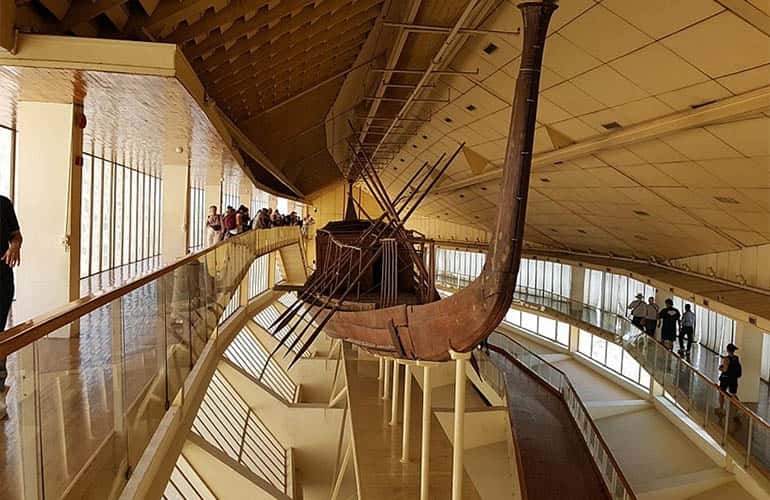Solar Boat Museum Or Khufu Ship:
On the south side of the Great Pyramid sits the pod-shaped, Solar Boat Museum. This holds a full-size ancient Egyptian boat discovered in pieces in 1954, lying in a pit beside the pyramid.
The so-called solar boat or Cheops’ ship, dated in 2,500 BC in the Early Bronze Age, is clearly, due to its dimensions and typology, a high sea vessel. It is a ship dedicated to trading with Lebanon, from where the Egyptians brought the cedarwood, so necessary for the construction of ships and buildings. The main port of Lebanon at that time was Byblos, hence the Egyptians used the expression “Byblos ship” as a synonym for a deep-sea vessel, to differentiate it from those sailing on the Nile river or fishing on the coast.

Khufu ship facts
Khufu Ship or solar boat is 43m50 long and 6m wide. She has a draft of 1m50.
It was found in spare parts in one of the five wells that surround the pyramid of Cheops. These pits were an integral part of the funerary complex of this pharaoh, with the pyramid, the enclosure, the temples up and down, the path that connects them and the pyramids attached.
This ship is composed of 1224 different pieces, some of which are marked with assembly instructions. It had a flight of 10 oars and therefore required five people to propel it, plus a helmsman at the back who used a pair of oars to steer it. In the center was a 9-meter-long, completely enclosed cockpit, plus two doors that opened, one forward and one backward. At the tip of the ship, there was a canopy that allowed protection from the sun.
The decoration is not left out, with interesting decorations at the stern and bow. She shows several beautiful papyrus leaves.
The solar boat of Khufu Ship was made of cedar and acacia wood, two common woods in the region at that time. Today these trees are much rarer, but we must think that there are 45 centuries that separate us from this era, while nature has changed.
When the ship was discovered in 1947, the question of its reconstruction arose. On the one hand, was it necessary to reassemble it and, if so, how?
Experts spent 14 years putting its 1200 pieces together again using only ancient Egyptian materials of wooden pegs and grass rope.
It is called a solar boat by archaeologists because it resembles the vessels seen in tomb paintings in which the sun-god makes his daily trip across the heavens.
It is not clear whether the boat was buried for the sun-god or for the pharaoh’s own journey across the heavens.
Marks on the wood suggest that the boat had been sailed before being buried. It could be that it served as a funerary barque, carrying the body of Khufu from Memphis to his tomb at Giza.
A second similar boat was located in a nearby pit but remains unexcavated.





